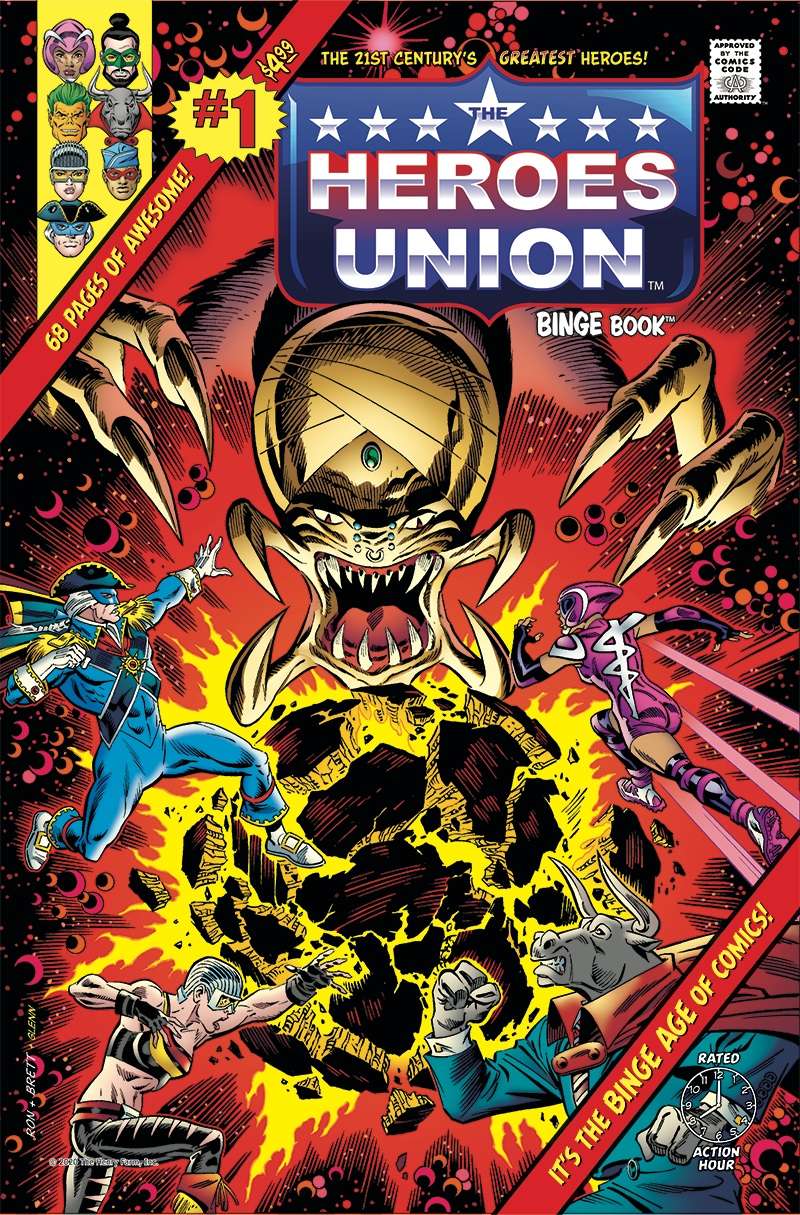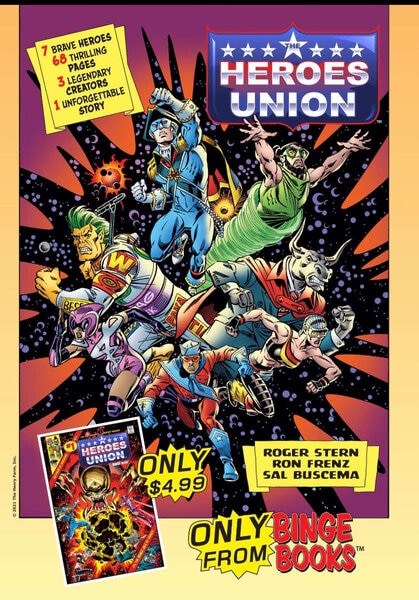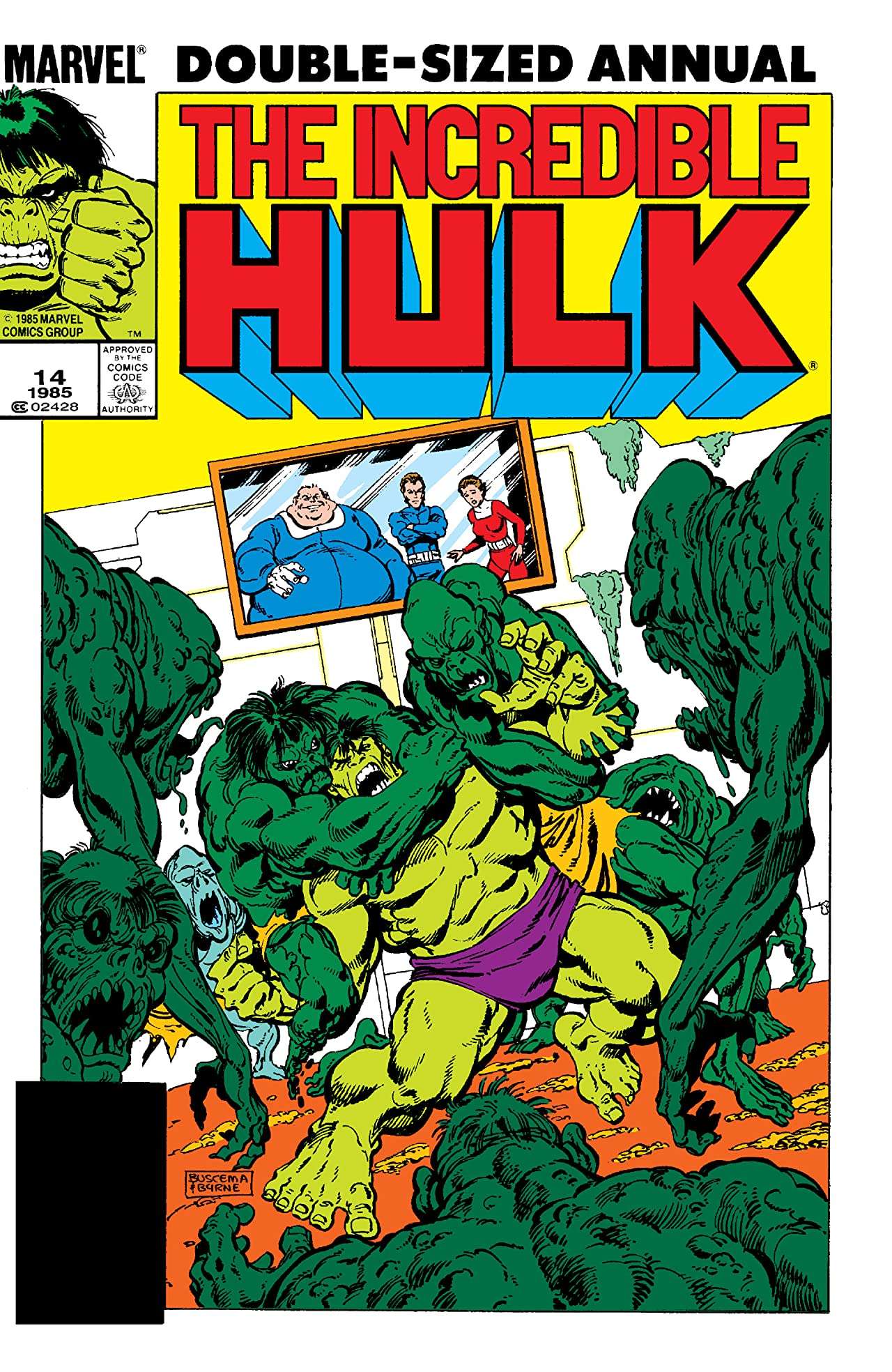Create a free profile to get unlimited access to exclusive videos, sweepstakes, and more!
Legendary artist Sal Buscema on his new Heroes Union project & six decades in the comics biz

Comics can be a heartless business. Yesterday's legends get discarded by shortsighted editors and publishers chasing hot fads. Even fans can take the greats for granted.
Recently, there was a discussion on Twitter where a clueless "fan" ridiculed some work done by Herb Trimpe near the end of his tenure at Marvel, in the 1990s. At the time, the hyper-muscular art styles made popular by young guns like Rob Liefeld and Jim Lee were setting the pace for the comics industry, and with comics being the copycat business that it is, editors wanted more of the same. Dependable workhorses like Trimpe either had to adapt their art styles to the current aesthetic or lose work. Trimpe tried to do it with decidedly mixed results. The original post that started the discussion was a cheap shot that was thankfully rebuked by a number of top comics talent, including Evan Dorkin, who thoughtfully explained the impossible situation an artist like Trimpe found himself in during the latter part of his career.
But the truth is, most of us have probably had to do tasks at work we weren't happy with because the alternative — unemployment — is too awful to face. No one is exempt from irrelevancy in comics. There are stories of Marvel staffers making fun of Jack Kirby's work during his late-'70s tenure. It's unimaginable to think that the greatest creator in comics was the butt of jokes in the Marvel bullpen.
Which is why artists like Sal Buscema are so exceptionally rare. One of the greatest and most prolific talents in the history of the biz, Our Pal Sal has a list of character credits to his name — including the Avengers, Spider-Man, the Defenders, the Hulk, and Thor — that would cover the length of the Rainbow Bridge. Remarkably, despite nearly 60 years as a professional artist, Buscema is still working. Although he says he's basically retired from penciling, he is still putting brush to paper as an inker.
His latest project is the new graphic novel The Heroes Union. The 68-page GN comes from the new imprint Binge Books and the first in a series of planned ongoing series. Hitting comics shops on Aug. 4, the standalone story is written by Roger Stern (The Avengers, Captain America) with pencils by Ron Frenz (Thor, The Amazing Spider-Man) and Brett Breeding (The Death of Superman, Avengers Next), and the 85-year-old Buscema handling the inks. The Heroes Union will introduce all-new 21st-century heroes who are part of an actual union of superheroes, complete with insurance plans, stipends, and, of course, secret headquarters.
"Welcome to the Binge Age of Comics!" That's the tagline for the new imprint. Given how much of an obstacle Marvel and DC's dense continuity can be for welcoming new readers, these stories — self-contained tales told by popular comics talent — could prove enticing to readers looking for a comics fix without having to commit to a serialized format.
For Buscema, it's a chance to continue to work in an industry he's been in since the 1950s, when he was inking pages for Dell Comics. Since the late '60s, his name has been synonymous with blockbuster comic book storytelling.
I always enjoy talking comics with any creator, but I was particularly excited to talk to Buscema for the first time. His energetic artwork and stunning storytelling were featured in countless Marvel comic books of the 1970s, when I started reading. Like John Romita with Spider-Man, when I picture the Hulk, it's Buscema's rendition of the Green Goliath that comes to mind. It's one reason why his original artwork is selling for six figures at recent auctions. For many comics fans, Sal Buscema is one of the definitive Marvel artists.
I was able to jump on the phone with Buscema recently to discuss his work on The Heroes Union, his mastery of drawing team books (not everyone can pull that off), why the Hulk is his favorite character to draw, and the impact Stan Lee had on his career. Read below for my exclusive interview with one of comics' all-time greats.
It's a great pleasure to talk with you because I've been a fan of your work for such a long time.
Sal Buscema: You're very kind, I really appreciate that.
I know that you know Roger Stern, Ron Frenz, and Brett Breeding. How did you wind up as the inker on The Heroes Union?
How I became the anchor on the book? They asked me to, it's as simple as that. They asked me if I would like to work on it and I said, "Absolutely." Because I love inking Ron's work. He's such a terrific draftsman and his pencils are really a joy to ink.
You've always been the type of inker who doesn't overpower the penciler's work. When you ink someone, you can still see the style of the original penciler. How do you approach the inking process?
Having been a penciler myself, I want to be true to the pencils [when I'm inking]. In Ron's case, it's a very easy thing to do because the pencils are so beautiful. All I have to do is just follow what he has done and you're very safe when you do that. You really can't go wrong as long as you know how to handle a brush and just follow what he does. I was like that when I was inking my brother John [Buscema]. I mean, he was such a fantastic draftsman and his pencils were so beautifully done that... I just wanted to be as true to his pencils as I possibly could be. And I did the same thing with Ron because he's equally talented.
Is it nice to be working on a story like The Heroes Union, where it's a standalone story that a reader can enjoy in one sitting?
Absolutely. That's what this is all about. We're communicating and we're trying to pass onto the public our story and entertain the public with it. It's always a joy, especially when you're working with someone like Ron Frenz. I love working with him and hopefully that comes across in the story to the reader.
Who's been the toughest penciler for you to ink in your career?
The toughest penciler to ink for me would probably be me, when I would ink my own work [laughs]. I think that would be a legitimate answer because I'm never satisfied with what I do. Whenever I penciled a book, I was always looking for ways to make it better. So I would do that with the brush. I should say I use a brush better than I use a pencil. For some reason, I've always been adaptable to the brush. I love the flexibility of the instrument. It's just a lot of fun being able to ink over a... especially a really good penciller. But also, when I had to ink pencils that were sort of borderline, I would very subtly without being nasty about it, and trying to be as true to the pencils as I could be. I would also try to make improvements. But when you're inking a Ron Frenz, a John Buscema, or a John Romita, you stay as true to their pencils as you possibly can.
Your output over the past 50 or so years is breathtaking. From your initial run on The Avengers with Roy Thomas, Captain America, and The Defenders with Steve Englehart, Marvel Team-Up, The Incredible Hulk and, of course, nearly the entire run of Rom: The Spaceknight... it's astounding the workload you had. I think at some point in the 1970s you were drawing at least two monthly books, as well as fill-in books and covers. How were you able to be so fast and maintain such a high storytelling quality?
I guess the only way I can explain it, is it was a gift. And I thank God for it because not only was I reasonably competent as a comic book illustrator, but I had the speed. So the people that I worked for, in this case Marvel, I was under contract with them for so many years. I worked for them, I don't know, 26 years or something like that. They kept me as busy as I wanted to be. I can't think of a time that I didn't have any work to do, except when I decided to take some time off on my own. I don't know. It was something that came very easy to me is the only way I can say it. It was so much fun. It wasn't work. I mean, what is that saying, that if you enjoy your work, you'll never work a day in your life? That's true.
One of the hallmarks of your career was your gift at drawing team books. First, The Avengers, then The Defenders, and you even filled in on the Fantastic Four as well. Not every artist could handle the demands and dynamics of a book full of heroes. Why were you able to excel at drawing books with so many heroes?
It's extra work and it's more difficult doing the group books. But for some reason I didn't have a problem with it. John and I used to discuss this all the time that we wish we could just do books with just single characters, but because we handled the group books so well, Marvel kept asking us to do them. And to be very practical about it, I was just happy to have the work because it's a business, and it's not a very secure business. When we finally went on contract [with Marvel], then we were guaranteed to work. But before that, and after the contract, there was no guarantee of getting any work. So if they asked me to do the group book, I was more than happy to do it because it kept me busy. And that's what I wanted to do. I wanted to be as busy as possible, make a good living, and be able to enjoy the fruits of my labor. I'm kind of an actor, too. I used to do community theater for 20 or so years, and I was able to utilize whatever ability I had and use it for comic book illustrating.
One of the books that I think most of your fans remember fondly is your time on The Incredible Hulk. To many fans — myself included — your Hulk is the one all others are measured against. You drew some 100 issues during the Bronze Age. Why did you like drawing the Hulk so much?
That is so gratifying to hear. And I thank you for that. The Hulk just happens to be my favorite comic book character. He wasn't your typical character that ran around saving the world every issue. But he was a character that you could do so much with… the anger element, when he changed back into Bruce Banner, it was just… there was just so much there to have fun with. And as I said, because of the fact that the Hulk was such a different type of character, not your typical spandex wearing superhero, he gave me so much to work with... the character did that. I really enjoyed my time on the Hulk.
I wish I could give you more than that, but really, when you're working on a book you're not really thinking about, "Why am I enjoying this?" You don't ask yourself those questions, you just do the work and turn it in when it's finished and then wait, hopefully, for the next job right behind it.
Storytelling is what it's all about. That's what we are, we're communicators. I guess it was something that was just a gift that I was given by God, that I was able to tell these stories. I really enjoyed getting the scripts from writers and turning it into pictures. It's a real challenge, but for some reason it came relatively easy to me. I don't want to pat myself on the back or anything. It was a joy for me to do. And one of the reasons I enjoyed working with these guys — Steve Englehart, J.M. DeMatteis, and Gerry Conway — is that it was easy to turn what they wrote into pictures. I didn't experience that 100% of the time with other writers. But for the most part, it was something that I never had a problem with. So I guess in that respect, I was very fortunate.
You mentioned your acting work before. How did the acting that you did in community theater help you? Would you take photos and act out movements?
Just the fact that I could stand up on a stage and communicate with other actors on the stage and communicate whatever was going on, whatever the play was or the music. I used to do a lot of musicals, believe it or not. And just communicating that to the audience. It was that element that helped me to communicate and be a good storyteller in comic books.
I read somewhere years ago that your big break at Marvel came after you went in for an interview with Stan Lee, and as he told you about working at Marvel, he basically acted out all sorts of things for you in his office. Is that how it happened?
My gosh. Yeah, it was really an experience that I remember very vividly to this day. One of the saddest moments of my life was when I found out that Stan had passed away, because he was such an important part of my life. I mean, he started my career in comic books. I had been an... illustrator working in studios in the Washington DC area for about, I don't know, 12 or 13 years. And the comic book industry was really dying. They just were not showing at all. And then Stan came along and kind of helped revolutionize things with Marvel. And the business and the sales started picking up again. And that's when my brother John got back into it. And I told him that I would love to take a crack at it. And he said, "Let me see if I can make an appointment with Stan Lee. You can bring up some work samples and show him." And that's what I did, I brought my samples and showed them to Stan. He liked them. And as they say, the rest is history. I've been doing them ever since.
Heads up for Alabama comics fans! Binge Books teamed up with Haven Comics to give away a page of original art from The Heroes Union for Free Comic Book Day, which this year falls on August 14. The page was penciled by Ron Frenz and inked by Sal Buscema. It will be given away to one person who pre-orders or purchases the book in-store from Haven Comics.
What's your favorite Sal Buscema-drawn book? I know, it's a near-impossible question because there are SO MANY GREAT CHOICES! (I lean toward his Spectacular Spider-Man run in the '90s). Find me on Twitter/Instagram and let me know your pick.
The views and opinions expressed in this article are the author's and do not necessarily reflect those of SYFY WIRE, SYFY, or NBCUniversal.




























